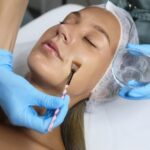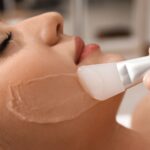
What is a Chemical Peel? Your Complete Guide to Skin Rejuvenation
September 1, 2025
Best Chemical Peel for Hyperpigmentation: Complete Treatment Guide
September 3, 2025Chemical peels have revolutionized skincare, offering a scientifically-proven pathway to healthier, more radiant skin. At Pōk Aesthetic Bar in Coral Gables, FL, we’ve witnessed countless transformations through various types of chemical peels, each designed to address specific skin concerns and deliver remarkable results.
Understanding the different types of chemical peels available can feel overwhelming, but this comprehensive guide will demystify the process and help you make informed decisions about your skincare journey. Whether you’re battling acne scars, sun damage, or simply seeking that coveted glow, there’s a chemical peel solution tailored to your unique needs.
What Are Chemical Peels and How Do They Work? 🧪
Chemical peels represent one of the most effective non-invasive skin treatments available today. These professional procedures use carefully formulated acid solutions to remove damaged outer layers of skin, revealing fresher, healthier tissue beneath.
The science behind chemical peels lies in controlled exfoliation. By applying specific concentrations of acids to the skin, we trigger a natural healing response that accelerates cell turnover and stimulates collagen production. This process addresses multiple skin concerns simultaneously, from fine lines and hyperpigmentation to acne and texture irregularities.
The different types of chemical peels work at varying depths, making them suitable for diverse skin types and concerns. Professional application ensures safety, efficacy, and optimal results that simply cannot be achieved with over-the-counter alternatives.
Superficial Chemical Peels: Your Gateway to Glowing Skin ✨
Superficial peels, also known as light peels, represent the gentlest category among types of chemical peels. These treatments penetrate only the outermost layer of skin (epidermis), making them ideal for beginners or those with sensitive skin.
Alpha Hydroxy Acid (AHA) Peels dominate this category, with glycolic acid and lactic acid leading the charge. Glycolic acid, derived from sugar cane, boasts the smallest molecular size among AHAs, allowing for deeper penetration and more dramatic results. Lactic acid, sourced from fermented milk, offers similar benefits with enhanced hydration properties.
These superficial treatments require minimal downtime, often dubbed “lunchtime peels” due to their convenience. Patients typically experience mild redness and slight flaking for 2-3 days, with results becoming apparent within a week.
The psychological benefits are immediate – patients report increased confidence and satisfaction with their appearance after just one session. However, optimal results require a series of treatments spaced 2-4 weeks apart.
Medium-Depth Chemical Peels: Addressing Deeper Concerns
Medium-depth peels penetrate through the epidermis into the upper dermis, making them more powerful than their superficial counterparts. These types of chemical peels effectively address moderate sun damage, deeper wrinkles, and stubborn pigmentation issues.
Trichloroacetic Acid (TCA) peels are the gold standard for medium-depth treatments. Available in concentrations ranging from 20-35%, TCA peels offer remarkable versatility in treating various skin conditions. The controlled injury they create stimulates significant collagen remodeling, resulting in firmer, smoother skin.
Jessner’s peels combine salicylic acid, lactic acid, and resorcinol in equal parts, creating a synergistic effect that’s particularly effective for acne-prone skin and melasma. This unique formulation self-neutralizes, reducing the risk of over-treatment while maximizing results.
Recovery from medium-depth peels involves more pronounced peeling and potential swelling for 7-10 days. However, the dramatic improvements in skin texture, tone, and overall appearance make this temporary inconvenience worthwhile for most patients.
Deep Chemical Peels: Maximum Transformation with Professional Care
Deep chemical peels represent the most intensive category among types of chemical peels, penetrating through the epidermis and deep into the dermis. These treatments deliver the most dramatic results but require careful patient selection and expert administration.
Phenol peels are the most powerful deep peel option, capable of addressing severe sun damage, deep wrinkles, and significant textural irregularities. The transformation achieved through phenol peels can be truly remarkable, often described as taking years off one’s appearance.
Due to their intensity, deep peels require extensive preparation and monitoring. Patients must undergo thorough medical evaluation, including cardiac assessment, as phenol can affect heart rhythm. Pre-treatment skin preparation with tretinoin and hydroquinone is typically necessary for 4-6 weeks.
The recovery process is substantial, involving 2-3 weeks of significant peeling and potential swelling. However, the results can last for years, making deep peels an excellent investment for those seeking maximum skin transformation.
Chemical Peel Comparison: Choosing the Right Treatment
| Peel Type | Depth | Downtime | Best For | Results Duration |
| Superficial (AHA) | Light | 2-3 days | Mild texture issues, maintenance | 3-6 months |
| Medium (TCA) | Moderate | 7-10 days | Sun damage, moderate wrinkles | 1-2 years |
| Deep (Phenol) | Deep | 2-3 weeks | Severe damage, deep wrinkles | 5-10 years |
| Jessner’s | Light-Medium | 5-7 days | Acne, melasma, uneven tone | 6-12 months |
| Mandelic Acid | Superficial | 1-2 days | Sensitive skin, maintenance | 2-4 months |
Specialized Chemical Peels for Specific Concerns 🎯
Beyond traditional categories, several specialized types of chemical peels target specific skin concerns with remarkable precision.
Mandelic acid peels offer the gentlest option for sensitive skin types. Derived from bitter almonds, mandelic acid’s large molecular size ensures slow, controlled penetration, minimizing irritation while delivering effective results.
Salicylic acid peels excel in treating acne-prone skin due to their oil-soluble nature, allowing deep penetration into pores to dissolve sebum and dead skin cells. These beta hydroxy acid treatments also possess anti-inflammatory properties, reducing redness and preventing future breakouts.
Combination peels represent the cutting edge of chemical peel technology, blending multiple acids to create customized treatments. These innovative formulations allow practitioners to address multiple concerns simultaneously while minimizing side effects.
The Science Behind Chemical Peel Efficacy
Understanding the biological mechanisms behind different types of chemical peels reveals why they’re so effective for skin rejuvenation. When acids are applied to the skin, they break down the bonds between dead skin cells, facilitating their removal and revealing healthy tissue beneath.
This controlled injury triggers the skin’s natural healing response, increasing collagen and elastin production. Growth factors are released, promoting cellular regeneration and tissue repair. The result is thicker, more resilient skin with improved texture, tone, and overall appearance.
Different acids work through varying mechanisms: glycolic acid disrupts keratinocyte cohesion, while salicylic acid dissolves lipids in pore walls. TCA causes protein coagulation, creating deeper injury and more substantial remodeling.
Pre-Treatment Preparation and Post-Care Excellence
Successful chemical peel outcomes depend heavily on proper preparation and aftercare. Pre-treatment protocols typically begin 2-4 weeks before your appointment, involving specific skincare products to optimize results and minimize complications.
Tretinoin preparation accelerates cell turnover, creating more uniform penetration of the chemical peel solution. Hydroquinone pre-treatment helps prevent post-inflammatory hyperpigmentation, particularly important for darker skin types.
Post-treatment care focuses on protecting healing skin and optimizing results. Gentle cleansing, consistent moisturizing, and diligent sun protection are non-negotiable elements of recovery. Following these protocols ensures optimal healing and maximizes the investment in your skin.
Safety Considerations and Professional Expertise
While various types of chemical peels offer remarkable benefits, they’re medical procedures requiring professional expertise. Improper application can result in scarring, hyperpigmentation, or other complications that may be permanent.
Professional assessment is crucial for determining the most appropriate peel type, concentration, and treatment protocol. Factors including skin type, medical history, current medications, and specific concerns must be carefully evaluated.
At Pōk Aesthetic Bar, our experienced practitioners undergo extensive training in chemical peel applications, staying current with the latest techniques and safety protocols. This expertise ensures that each treatment is both safe and effective.
Investment in Your Skin: Cost vs. Value Analysis 💰
The financial investment in professional chemical peels varies significantly based on the type and depth of treatment chosen. Superficial peels typically range from $150-300 per session, while medium-depth treatments may cost $300-800. Deep peels represent a larger investment, often exceeding $1,000.
However, when evaluating different types of chemical peels, consider the long-term value rather than just immediate cost. A series of superficial peels may ultimately cost more than a single medium-depth treatment while delivering less dramatic results.
The return on investment extends beyond mere aesthetics. Improved skin health often reduces the need for expensive skincare products and makeup, while enhanced confidence can positively impact personal and professional relationships.
Conclusion
The world of types of chemical peels offers unprecedented opportunities for skin transformation and rejuvenation. From gentle superficial treatments perfect for maintenance to powerful deep peels capable of dramatic transformation, there’s a solution for every skin concern and lifestyle.
Understanding the different types of chemical peels empowers you to make informed decisions about your skincare journey. Whether you’re seeking to address specific concerns or simply maintain healthy, glowing skin, professional chemical peels represent one of the most effective tools available in modern aesthetic medicine.
The key to success lies in partnering with experienced professionals who can guide you toward the most appropriate treatment options. With proper selection, preparation, and care, chemical peels can deliver remarkable results that enhance both your appearance and confidence for years to come.
Ready to discover which types of chemical peels are perfect for your skin? Schedule your consultation today with Pōk Aesthetic Bar at 4649 Ponce de Leon Blvd, Suite 406, Coral Gables, FL 33146 and take the first step toward your best skin ever.
Frequently Asked Questions (FAQs)
Q: How long do different types of chemical peels take to show results?
A: Superficial peels show initial results within 3-5 days, with optimal results after 1-2 weeks. Medium peels reveal improvements after 1-2 weeks, with continued enhancement over 3-6 months. Deep peels show dramatic results after 2-4 weeks of healing.
Q: Can I get chemical peels year-round, or should I avoid certain seasons?
A: While chemical peels can be performed year-round, fall and winter are ideal due to reduced sun exposure. All types of chemical peels increase photosensitivity, making diligent sun protection essential regardless of timing.
Q: What is the best type of chemical peel for acne scars?
A: Medium-depth TCA peels and deep phenol peels are most effective for acne scars. However, a series of superficial peels combined with microneedling may also provide excellent results for mild to moderate scarring.
Q: How often can I receive different types of chemical peels?
A: Superficial peels can be repeated every 2-4 weeks, medium peels every 3-6 months, and deep peels are typically one-time treatments lasting several years. Your practitioner will create a personalized schedule based on your skin’s response.
Q: Are chemical peels safe for all skin types and ethnicities?
A: Most types of chemical peels can be safely performed on all skin types, but darker skin tones require special consideration and modified protocols to prevent hyperpigmentation. Professional assessment is crucial for optimal safety and results.
People Also Ask
What’s the difference between at-home and professional chemical peels? Professional chemical peels use higher concentrations of active ingredients and are applied by trained specialists who can assess your skin and adjust treatment accordingly. At-home peels are much gentler and cannot achieve the same dramatic results as professional treatments.
Do chemical peels hurt, and what does the sensation feel like? Most people experience a mild to moderate stinging sensation during application, similar to a sunburn feeling. Superficial peels cause minimal discomfort, while deeper peels may require pain management. The sensation typically subsides within minutes of application.
Can I wear makeup after getting a chemical peel? Makeup application depends on the type of peel received. After superficial peels, mineral makeup can usually be applied the next day. Medium and deep peels require waiting until peeling is complete, typically 7-14 days, to avoid irritation and infection.
What should I avoid after getting a chemical peel? Avoid sun exposure, picking at peeling skin, using harsh products, exercising vigorously, and applying retinoids or acids until your skin has fully healed. Your practitioner will provide detailed post-care instructions specific to your peel type.
How do I choose between different types of chemical peels? The best peel type depends on your skin concerns, tolerance for downtime, and desired results. A professional consultation is essential to evaluate your skin type, medical history, and goals to recommend the most appropriate treatment plan.

